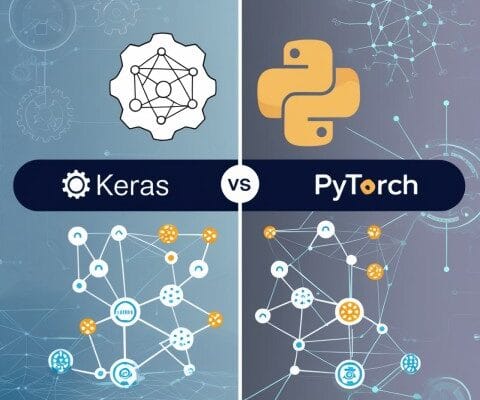Keras PyTorch: A Comprehensive Guide to Deep Learning Frameworks
In the world of artificial intelligence (AI) and machine learning (ML), tools and frameworks like Keras PyTorch have become indispensable. These frameworks empower researchers and developers to design, train, and deploy state-of-the-art deep learning models. While Keras and PyTorch are often compared due to their popularity, their unique strengths make them essential tools for different purposes.
This article dives deep into the features, advantages, and limitations of Keras PyTorch, helping you understand their roles in the deep learning landscape.
Introduction to Keras PyTorch
Keras: Simplifying Deep Learning
Keras, a Python-based high-level neural network library, emphasizes simplicity and ease of use. Developed by François Chollet, Keras was initially designed as an interface for multiple backends such as TensorFlow, Theano, and CNTK. With the advent of TensorFlow 2.0, Keras became an integrated part of TensorFlow, solidifying its position in the AI community.
PyTorch: Empowering Research
PyTorch, developed by Facebook’s AI Research lab, is a Python-based framework built on Torch. Known for its dynamic computation graph and flexibility, PyTorch has become a favorite among researchers and practitioners in academia and industry.
Together, Keras PyTorch represent two of the most powerful tools in the deep learning toolkit, offering solutions to diverse challenges in AI development.
Core Features of Keras PyTorch
Features of Keras
- User-Friendly API:
- Keras simplifies the process of building and training neural networks, making it an excellent choice for beginners.
- Rapid Prototyping:
- The high-level nature of Keras allows for fast experimentation with minimal code.
- Integration with TensorFlow:
- With TensorFlow as its backend, Keras benefits from advanced features like TensorBoard and TensorFlow Lite.
- Pre-Trained Models:
- Keras provides a library of pre-trained models for applications like image recognition, object detection, and natural language processing (NLP).
- Cross-Platform Support:
- Models built with Keras can be deployed on CPUs, GPUs, and TPUs.
Features of PyTorch
- Dynamic Computational Graph:
- PyTorch allows for dynamic graph creation, enabling real-time modifications to the model during training.
- Flexibility:
- Its low-level design provides users with complete control over every aspect of model development.
- TorchScript:
- TorchScript bridges the gap between research and production by allowing models to be serialized and optimized.
- Growing Ecosystem:
- PyTorch has specialized libraries like
torchvisionfor computer vision,torchaudiofor audio processing, andtorchtextfor NLP.
- PyTorch has specialized libraries like
- Research-Oriented:
- PyTorch is widely adopted in academia, with many research papers leveraging its capabilities.
Keras PyTorch Comparison
When deciding between Keras and PyTorch, it’s essential to consider your project requirements and expertise. Let’s explore the differences across key parameters:
Ease of Use
- Keras: Offers an intuitive, high-level API designed for ease of use. Ideal for beginners and rapid prototyping.
- PyTorch: Provides a lower-level interface, requiring a steeper learning curve but offering greater flexibility for advanced users.
Performance
- Keras: Optimized for simplicity and efficiency in standard use cases.
- PyTorch: Offers high performance for custom and complex tasks, making it ideal for research applications.
Debugging and Flexibility
- Keras: Debugging can be challenging due to its high-level abstractions. However, TensorFlow’s debugging tools, such as TensorBoard, improve the experience.
- PyTorch: The dynamic graph feature enables easier debugging and experimentation during runtime.
Deployment
- Keras: Leverages TensorFlow’s ecosystem for deployment, supporting TensorFlow Lite and TensorFlow.js.
- PyTorch: Uses TorchScript for model serialization, making it production-ready for real-world applications.
Use Cases for Keras PyTorch
Keras
- Rapid prototyping and model development.
- Projects that require transfer learning or pre-trained models.
- Deployment on mobile or edge devices.
- Ideal for beginners learning deep learning concepts.
PyTorch
- Research requiring custom architectures or algorithms.
- Dynamic modeling tasks like reinforcement learning.
- Integration with other Python-based libraries for unique applications.
- Production-ready solutions using TorchScript.
Choosing Between Keras PyTorch
Both Keras PyTorch frameworks have strengths tailored to different use cases:
- Choose Keras if:
- You are new to deep learning.
- You want to build standard models quickly.
- You are looking for seamless deployment options within TensorFlow’s ecosystem.
- Choose PyTorch if:
- You need flexibility and control over model design.
- You are working on cutting-edge research or custom tasks.
- You require dynamic computational graphs for experimentation.
Future of Keras PyTorch
The popularity of Keras and PyTorch continues to grow, with each framework playing a vital role in advancing AI. TensorFlow’s integration of Keras and PyTorch’s research-driven design ensures that both will remain critical tools for developers and researchers alike.
With the advent of hybrid frameworks and tools aiming to combine the strengths of Keras PyTorch, the future of deep learning looks promising. Mastering both frameworks is becoming increasingly valuable for AI practitioners.
Conclusion
In the debate of Keras PyTorch, there is no definitive winner. Both frameworks serve distinct audiences and purposes. Keras shines in its simplicity and ease of use, while PyTorch excels in flexibility and research-oriented design.
Understanding the differences between Keras PyTorch and leveraging their strengths based on project requirements can significantly enhance your capabilities as a deep learning practitioner. By mastering both, you can unlock the full potential of these powerful frameworks in your AI journey.



